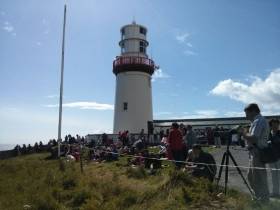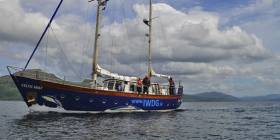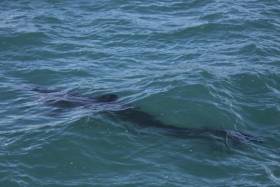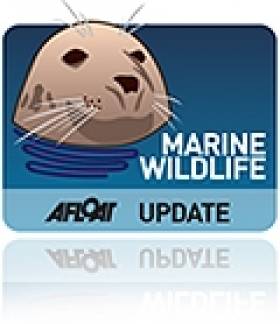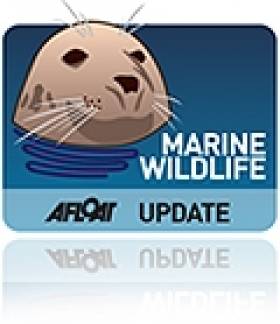Displaying items by tag: IWDG
Save The Date For 2016 All Island Whale Watch Day
#WhaleWatchDay - The 2016 All Island Whale Watch Day takes place on Saturday 27 August as part of Heritage Week.
All are invited to join the Irish Whale and Dolphin Group (IWDG) at any of 20 land-based whale watches on headlands around the Irish coast from 2pm-5pm on the day.
The purpose of Whale Watch Ireland is to raise awareness of the 25 species of cetaceans – whales, dolphins and porpoises – recorded to date in Irish waters, by providing the opportunity to see them in their natural environment.
The event also provides IWDG researchers with a unique snapshot of cetacean activity off the Irish coast.
Though sightings can't be guaranteed, the early arrival of humpback whales among others this year is surely a good omen, especially for those along the south coast between West Cork and Wexford.
And with three-quarters of sites reporting whale or dolphin sightings on last year's Whale Watch Day, the odds are good for next month.
No prior experience is necessary as IWDG volunteers will be on hand to show you how to observe our biggest marine wildlife.
Anyone who wants to come out on the day should bring binoculars or a spotting scope, and dress appropriately for what can be very changeable outdoor conditions.
Details of the 20 headland watch sites are listed below; contact the relevant local organiser for more details or if you wish to help out on the day:
- Clogherhead, Co Louth - Port Oriel Upper Car Park - Breffni Martin, 087 914 5363
- Howth Head, North Co Dublin - Balscadden Car Park - Conal O’ Flanagan, 086 353 7900
- Killiney Bay, South Co Dublin - Vico Road - Brian Glanville, 087 139 0665
- Bray Head, Co Wicklow - Pitch & Putt - Justin Ivory, 087 683 3898
- Hook Head, Co Wexford - Lighthouse - Harm Deenen, 086 348 5013
- Ardmore, Co Waterford - Ram Head Signal Tower - Andrew Malcolm, 087 795 2061
- Galley Head, Co Cork - Lighthouse - Pádraig Whooley, 086 385 0568
- Hog’s Head, Co Kerry - Sea Synergy Centre, Waterville - Lucy Hunt, 087 785 0929
- Valentia Island, Co Kerry - Bray Head Signal Tower - Sean O’Callaghan, 085 776 4918
- Clogher Head, Co Kerry - Lay-by - Nick Massett, 087 673 6341
- Loop Head, Co Clare - Lighthouse - Simon Berrow, 086 854 5450
- Black Head, North Co Clare - Lighthouse - Sandra O’Donovan, 086 606 1869
- Downpatrick Head, Co Mayo - Car park - Aoife Foley, 085 827 6984
- Mullaghmore Head, Co Sligo - Lay-by - Miriam Crowley, 087 617 1377
- Bloody Foreland, Co Donegal - Heights Bar car park - Gareth Doherty, 086 222 3328
- Malin Head, Co Donegal - Signal Tower - Ronan McLaughlin, 086 389 3154
- Ramore Head, Co Antrim - Portrush Coastal Zone - Jim Allen, 078 765 16032
- Portmuck, Co Antrim - Car park - Ian Enlander, 028 933 72724
- Bloody Bridge, Co Down - Car park - Dave Wall, 077 717 62355
#BowheadWhale - The search continues in tracking down the elusive bowhead whale that's excited marine wildlife experts since it was sighted in Carlingford Lough at the weekend.
One of a species never before recorded in Irish waters in the 25 years since the Irish Whale and Dolphin Group (IWDG) was formed, the 20ft juvenile whale was photographed from a pilot boat at the mouth of the lough at the Helly Hunter Rocks on Sunday 29 May.
It's thought that it may be the same individual from the arctic species spotted off Cornwall in mid May, following a previous bowhead sighting at the Scilly Isles in February.
The Celtic Mist joined the hunt yesterday (Tuesday 31 May) on its circumnavigation of Ireland and failed to make any sighting, though bowhead whales are known for being difficult to spot due to their lack of a dorsal fin.
The IWDG has much more on this story HERE.
#MarineWildlife - Places are going fast for a special cruise on board the Irish Whale and Dolphin Group's Celtic Mist to celebrate the 25th anniversary of Ireland's whale and dolphin sanctuary.
Celtic Mist will depart Fenit, Co Kerry next Saturday 7 May with a team of IWDG members and marine science experts on an almost three-month circumnavigation of Ireland, first heading north along the Wild Atlantic Way and around to the Irish Sea, calling on Dublin on 7 June to mark the 25th anniversary of the Irish Government's official declaration of this island's waters as a sanctuary for cetaceans.
The declaration came only three months after it was proposed by the then newly formed IWDG, and both have been instrumental in raising awareness of the bounty of marine wildlife in Irish waters.
Though berths on the voyage are filling fast, everyone will have the opportunity to participate by assisting in outreach events along the cruise route, or by tracking its progress online. Details on how to get involved can be found on the IWDG website HERE.
Along the way passengers on Celtic Mist may be treated to some of the incredible wildlife the sanctuary was created to protect, such as humpback whales – a number of which were spotted on an early visit to West Kerry earlier this month, likely attracted by schools of sand eels, as the IWDG reports.
In other marine wildlife news, locals near a beach close to Ballyshannon in Co Donegal have complained after a whale carcass was left rotting on rocks three days after it was reported to authorities.
According to the Irish Mirror, successive high tides had failed to shift the 25ft minke whale, though Donegal County Council says it is arranging for the animal's disposal.
Basking Sharks Spotted In Big Numbers Off Kilkee (video)
#BaskingSharks - Conservationist Andrew Power was in the right place at the right time on Monday morning (11 April) when he witnessed a group of up to 20 basking sharks feeding off Kilkee, Co Clare.
"You could see the inside of their huge mouths very clearly under the water as they were feeding," Power told RTÉ News of the three-hour breakfast. "They swam close to the rocks going in circles. It was incredible."
The Irish Whale and Dolphin Group (IWDG) reports that another sighting was made at the same time off Slea Head in Co Kerry – adding to a list of inshore sightings along the South West coast since 31 March, when the first basking shark spotting of 2016 was reported off West Cork.
Regular visitors to our shores, the second largest fish in the ocean were last seen in numbers back in September, as previously reported on Afloat.ie.
And the sheer size of this group is surely a boost for the 'shark park' initiative mooted for the Wild Atlantic Way last summer.
VIDEO: A close encounter with basking sharks off the Clare coast.https://t.co/d3ozNFg8RI
— RTÉ News (@rtenews) April 12, 2016
Whale Sightings Boost In Sunny South East
#MarineWildlife - Whale sightings are on the increase in the South East this week as the season tapers off, according to the Irish Whale and Dolphin Group (IWDG).
"As large whales don't keep to our calendar year, this annual south east flurry of large whale sightings represents the tail-end our our large whale season," says the IWDG's sightings officer Pádraig Whooley.
"And what a season it has been, especially for the humpback whale, which have enjoyed a record year both in terms of frequency of sightings since they first appeared in early May off the Slea Head Peninsula."
The latest spots were made both on land – by Andrew Malcolm and Ann Trimble from Ardmore Co in Waterford at the weekend – and on a whale-watching trip with Martin Colfer's South Coast Charter Angling, recording a humpback whale and more than five fin whales between them.
And there might still be time to head down to the Sunny South East to catch a glimpse of these ocean giants before they depart for the spring.
Voyages out as far as the edge of the Continental Shelf on the Atlantic Ocean has produced rare sightings for the Irish Whale and Dolphin Group and this August there is a chance to see the join the crew and see the whales again writes Patrick Lyne
Back in 2012 when the Celtic Mist became available to the Irish Whale and Dolphin Group we were looking at ways the boat could be used to support the work the Group does and demonstrate to people in Ireland the wealth of life that exists in Irish waters. So for three years from 2012 to 2014 we took the Celtic Mist to the shelf edge in early September. Indeed we were blessed when first arriving on the shelf edge only to be greeted by two blue whales. It took several minutes in close proximity (200m) to the whales before we believed our eyes. We had expected large whales but not those to be waiting for us. They stayed around and passed either side of the boat moving from port to starboard for what seemed like an age, before moving further away. We could manage a top speed of maybe 8 knots while blue whales could travel at up to 25 knots approximately and there was no way we could keep pace with these animals if they decided to leave us behind.
Shortly afterwards the Irish Air Corps Casa (C253) appeared and called on the radio and managed to get some excellent shots of both the Celtic Mist and the blue whales.
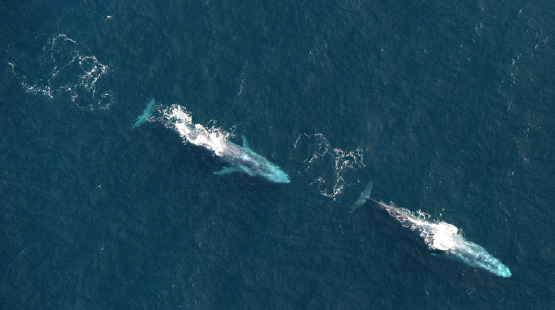 Two blue whales in the Porcupine Seabight 60 miles off the Irish coast (Photo coutesy of Irish Air Corps)
Two blue whales in the Porcupine Seabight 60 miles off the Irish coast (Photo coutesy of Irish Air Corps)
In 2013 had some remarkable sightings of beaked whales again in the Porcupine Seabight and while unable to confirm that the animals that passed close to the vessel in 2013, were True’s beaked whales, it seems highly probable that they were. Beaked whales are particularly difficult to study being adverse to noise and spending large periods of time underwater. The Cuvier’s beaked whale holds the record for the longest recorded dive of any cetacean of 2 hours 17 minutes while attaining a depth of 2,992m. These animals are rarely seen close to shore and when they are, they often end up stranding and dying. The deep ocean off the shelf edge is their natural habitat.
Each year has produced it’s own spectcular moments and the humpback whales off Dingle have become more and more reliable and are a feature of our trips every year. Last year we were treated to one beautiful day on the shelf edge with calm weather. It is this calm weather that always produces the best results. While whales numbers wer not spectacular they were considerable and most if not all animals were engaged in feeding. We simply allowed the boat to drift while fin whales fed in close proimity to the boat and we could see the huge jaws opening to envelope the krill underwater.
Last year we changed vessels to Jessy of Adrigole a 37 ft–yacht, the Celtic Mist being unavailable and this year we have decided to continue using Jessy but for a longer trip. We propose starting in Castletownbere and sailing to Camaret in Brittany along the shelf edge. The shelf edge between here and Brittany is some of the most dramatic in the world with drop offs from 200m down to nearly 4000m. The EEZ of the UK is slowly squeezed such that French and Irish waters will eventually meet as boundaries extend.
It is more important than ever to record the variety and abundance of Ireland’s offshore environment. While oil exploration will suffer from the current over supply, exploration rights has been granted to both Russia and France by the International Seabed Authority (ISA – not the Irish Sailing Association but a UN body based in Jamaica) in the mid-Atlantic Ridge in the North Atlantic. The marine environment is constantly under greater and greater pressure. Protection for cetaceans is critical to mainting the entire marine habitat. Reduction in large whale numbers in the Southern Ocean due to whaling did not result in an increase in their favourite prey, krill, but rather reduced krill abundance. Whale faeces enriches the ocean with iron, producing plankton blooms which start the food chain and absorb excess carbon from the atmosphere. The South West in particualr sees large numbers of tuna arrive in August and September, follwoed by French and Spanish and Irish fishing vessel as well as whales. It is important for the whales that they are able to build blubber reserves at this time, especially for the females as without sufficient reserves to sustain them during pregnancy of 11 or 12 months, the whale will abort. Recovery rates are slow with these large whales and even with protection it will be manay many decades before fin and blue whale numbers reach pre-whaling levels.

Fin whale feeding Porcupine Seabight (Photo – Patrick Lyne IWDG)
In August we will embark again to try and find calm weather on the shelf edge and hope to add significantly to the picture of cetaceans in Irish waters in a time when they are at their most abundant. It is a unique opportunity for people to become involved with our marine mega fauna in a way not available elsewhere and to add to knowledge of the area. The charge to crew of €1310 allows the work to take place and is an enriching experience and an education. If interested contact Patrick Lyne by email ([email protected]).
Irish Research Cited In Experts' Rejection Of Japan Whaling Plan
#MarineWildlife - A research paper produced in a joint project by the Irish Whale and Dolphin Group (IWDG) and the Galway-Mayo Institute of Technology (GMIT) was cited by an expert panel that has struck down Japan's plans to resume whaling in the Southern Ocean.
As the Guardian reports, the International Whaling Committee (IWC) panel said Japan's revised programme did to have enough detail to determine whether it needed to hunt whales in order to, as per its reasons, measure population sizes ahead of any return to commercial whaling, or gain "a better understanding of the Antarctic marine ecosystem".
"The current proposal does not demonstrate the need for lethal sampling to achieve those objectives," said the IWC experts' report.
The IWDG-GMIT paper lead authored by Dr Conor Ryan and published in Marine Ecology Progress Series in 2013, which details the collection of relevant data from live biopsy tissue samples, was cited by the experts as evidence contrary to Japan's assertions.
Japan was forced to revise its whaling programme in the face of controversy last year after the International Court of Justice ruled it was not whaling for scientific research purposes.
The IWDG says that the IWC's report "endorses the internationally significant work being carried out in Ireland and shows how this information can be used to inform important management decisions such as that offered by the IWC Expert Panel."
Other recent research work conducted by the IWDG includes a visual and acoustic survey of cetaceans during the annual Marine Institute bus whiting survey, and a review of the National Parks and Wildlife Service's National Cetacean Protection Strategy.
Irish Whale & Dolphin Group Hosts AGM In Dublin Tomorrow
#MarineWildlife - The Irish Whale and Dolphin Group (IWDG) hosts its annual general meeting at the Best Western Plus Academy Plaza Hotel at the top of O'Connell Street in Dublin tomorrow 8 November 2014.
The event, which kicks off at 2pm, is open to all IWDG members (with voting on proposals for members of at least six months' standing) and will provide an opportunity for people to learn more about the marine wildlife charity's work, and how to get more involved.
Talks On Whale & Dolphin Monitoring In Belmullet This Thursday
#MarineWildlife - The Irish Whale and Dolphin Group (IWDG) will be co-hosting an evening of talks on cetacean research at the Belmullet Civic Centre this coming Thursday 27 March.
Held in conjunction with the Coastal & Marine Research Centre at University College Cork, the evening will see a talk by Barry McGovern on the CMRC's work in Broadhaven Bay as part of the Corrib Gas Project in Co Mayo over the past decade.
In addition, the IWDG's Dr Simon Berrow will look at whale and dolphin strandings around Ireland, with a focus on Belmullet.
The IWDG has more details on the evening HERE.
#MarineWildlife - A humpback whale new to Irish waters has been confirmed by the Irish Whale and Dolphin Group (IWDG).
Photos of the humpback's fluke and dorsal fin captured by Nick Massett off Clogher and Sybil Heads in West Kerry at the weekend were examined by the IWDG's catalogue experts who have determined that the whale is a new arrival - and one with a fluke colouring that's rarely seen in Irish waters.
Details have since been sent to Allied Whale in the US state of Maine - which curates the North Atlantic humpback whale catalogue - to see if a match can be made among its database of more than 7,000 fluke images.
Meanwhile, Wildlife Extra reports that sailors in the Irish Sea are urged to keep a lookout for a large group of minke whales.
The group includes three juveniles and a calf previously spotted some 19 miles east of Ireland's Eye near Howth.
"Although sightings of Minke whale are to be expected in these waters, such a large group is a rare occurrence," said Danielle Gibas, sightings officer with the UK's Sea Watch Foundation, which is organising Britain's annual National Whale and Dolphin Watch this week till 3 August.
And in other cetacean news, scientists claim that dolphins call each other by name, calling back to the sound of their signature whistle but ignoring whistles that aren't theirs.
Herald.ie reports on the findings by marine scientists at the University of St Andrews, who studied a bottlenose dolphin group off the east coast of Scotland.
Using underwater speakers, they played synthesised versions of dolphin whistles they'd identified with particular dolphins to determine their reactions.
They were surprised to find that individuals called back after hearing their own 'name' but ignored others, whether they were for dolphins in the same group or strangers.


























